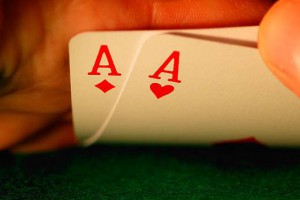The most-profitable size for a no-limit bet in Poker
Not as simple as it may seem to be
What’s the right size for a no-limit bet? In limit poker games, there’s only one permitted size for each bet and each raise. In no-limit games, you can bet anything from the size of the big blind on up to as many chips as you have on the table.
If you’ve seen a lot of Old West movies, you’ve probably seen someone bet and another opponent suddenly raise $50,000 or so. And the poor cowboy who made the bet is forced to squirm and say something like, “I don’t have enough money to call.”
“Well, I guess I win then,” says the raiser, beginning to rake in an enormous pot.
“Wait! I call you with the deed to grandpa’s ranch.”
If poker had really been played like that, the player with the greatest resources could always win any pot by betting more than an opponent could afford. It would be as silly in real life as it is in the movies. That’s why no-limit poker is played table stakes. If you have $1 million on the table and the most any opponent has is $5,000, then the biggest possible bet will be $5,000. You can wager the $1 million for show, but most of it won’t count.
So, no-limit isn’t really what the name implies. It is range limit. In a no-limit game with $25 and $50 blinds, you can bet anything from $50 on up to the maximum you have on the table that an opponent can equal. And here’s where it gets complicated.
There’s a popular argument that says that limit poker is actually more skillful than no-limit, because no-limits results center on just a few big bets. And, in no-limit, if you hold a big hand, you will usually “protect” it by moving all-in for all your chips. This is not true.
No-limit is much more complex and requires more skill than limit. Period. When you play limit, you are only faced with decisions about whether to bet, raise, or call an exact amount. These limit bets lose their intimidation factor as the pot grows proportionally large. Maybe you’d like to bet $3,000 into a $2,000 pot, but you can’t. You can only bet $200.
But no-limit is much different. You don’t just decide whether to bet or raise, you must decide how much. And that changes everything. What’s a correct bet? Conventional wisdom says that an average bet is the size of the pot. That’s convenient, but I don’t like it. For me, an average bet with a typical hand, strong enough to wager, but not unbeatable, will be less than the size of the pot. About two-thirds works well for me. I average bigger bets or slightly smaller ones in direct relation to the strength of my hands.
Notice I said that I average bigger bets. You can’t use as straight-line formula—with bigger hands resulting in correspondingly bigger bets—or opponents can gauge the strength of your hands by how much you bet. You need deception, but bigger hands should merit bigger bets on average.
There’s another no-limit theory I dispute. It says that in no-limit games you should make your bets the same size, regardless of the strength of you hand. That doesn’t compute.
Do as I recommend. Bigger hands equal bigger bets. Throw in bluffs, too. And sometimes you’ll act deceptively to trap opponents when you hold those monster cards. Put that all together and no-limit is more sophisticated, more demanding, and more skillful than limit.
Final advice
Some players believe the best thing to do with a powerful hand is to move all-in, making your opponents pay the maximum should they try to draw out on you. This is wrong, too. When you have a strong hand, you have something to sell. You want the best price possible. If you hold two pair after the turn in hold ’em and your opponent is trying for a flush in a $10,000 pot, it’s about 4-to-1 against him drawing out on you. If you bet $2,500, he’ll be facing a pot of $12,500 (the original $10,000 plus your $2,500 bet) and it will cost him $2,500 to call. You’re offering him pot odds of 5-to-1. You’re losing money on the sale – selling too cheaply. The trick is to make your bet high enough so that your opponent isn’t getting the best of it by calling. Then add as much to that as you think will bring you the most long-term profit.
When you hold that winning hand in no-limit, your bet should be large enough that your opponent isn’t getting the advantage by calling. Then see if you can price it higher for extra profit. One of the key skills in no-limit poker is getting your opponents to pay too much. But if you always go all-in or price your hand too high, they might not buy.
| HOT TIP If you act immediately when you spot a tell in poker, your opponent is likely to associate his mannerism with your action and correct the mistake in the future. Hesitate, seem unsure, and then act. That way, your response is likely to be interpreted as a lucky guess, rather than the result of a tell. Then the tell is apt to go uncorrected and you can profit from it again in the future.—Mike Car0 |



